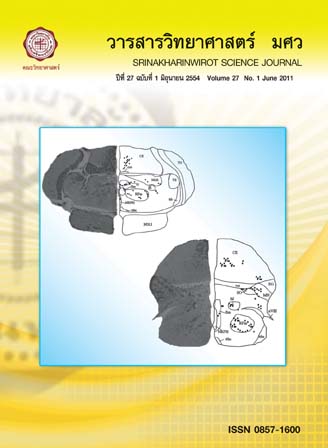การออกแบบเซ็นเซอร์เพื่อใช้ตรวจวัดไอออนโลหะเชิงคุณภาพและปริมาณวิเคราะห์ด้วยเทคนิคฟลูออเรสเซนซ์สเปคโทรสโกปี
Keywords:
ฟลูออเรสเซนซ์เซ็นเซอร์ การตรวจวัดไอออนโลหะหนัก fluorescent sensors, metal ions detectionAbstract
ไอออนโลหะมีบทบาทและหน้าที่สำคัญในระบบชีวภาพและในสิ่งแวดล้อม หลายชนิดมีประโยชน์ในระบบชีวภาพ เช่น แคลเซียม โซเดียม และ สังกะสี ในขณะที่บางชนิดมีความเป็นพิษร้ายแรงเช่น ปรอท แคดเมียม และ ตะกั่ว การนำเทคนิคฟลูออเรสเซนซ์สเปคโทรสโกปีมาใช้ในการตรวจวิเคราะห์ไอออนโลหะเชิงคุณภาพและปริมาณวิเคราะห์นั้นจะทำให้สามารถตรวจสอบไอออนโลหะได้รวดเร็ว และ ไม่ทำลายสารตัวอย่าง ในช่วงเวลาไม่นานมานี้ได้มีการออกแบบและสังเคราะห์สารประกอบอินทรีย์ชนิดใหม่หลายชนิดขึ้นเพื่อใช้เป็นฟลูออเรสเซนซ์เซ็นเซอร์เนื่องจากสารประกอบเหล่านี้สามารถนำมาใช้ตรวจวัดไอออนโลหะได้อย่างมีความจำเพาะเจาะจงและมีสภาพไวในการตรวจวัดสูง การออกแบบเซ็นเซอร์จะคำนึงถึงขนาดช่องว่างของเซ็นเซอร์ที่เหมาะสมกับขนาดไอออน และ/หรือ การเกิดอันตรกิริยาของอะตอมในโมเลกุลเซ็นเซอร์ที่เหมาะสมกับชนิดไอออน ฟลูออเรสเซนซ์เซ็นเซอร์ส่วนมากได้ถูกออกแบบให้ทำงานผ่านกลไกการถ่ายเทอิเล็กตรอน หรือ การถ่ายเทประจุ ดังเช่น กระบวนการ photoinduced electron transfer (PET) และ กระบวนการ photoinduced charge transfer (PCT) นื่องจากสารประกอบเหล่านี้สามารถนำมาใช้ตรวจวัดไอออนโลหะได้อย่างมีความจำเพาะเจาะจงสูง และ มีความว่องไวสูงในบทความนี้จะกล่าวถึงการพัฒนาฟลูออเรสเซนซ์เซ็นเซอร์ในปัจจุบัน โดยจะเน้นหลักการออกแบบเซ็นเซอร์โดยใช้ลักษณะของโครงสร้างโมเลกุลของเซ็นเซอร์ กลไกทางฟลูออเรสเซนซ์ และ ตัวอย่างการประยุกต์ใช้งานของเซ็นเซอร์ชนิดนี้Metal ions play an important role in many biological and environmental systems. Many types of metal ions are essential in biological systems such as calcium, sodium and zinc ions; however, some metal ions are very toxic such as mercury, cadmium and lead ions. Fluorescence spectroscopy can be very useful in the qualitative and quantitative detection of metal ions. The method is rapid and nondestructive to samples. Recently, a number of organic molecules have been designed and synthesized as new fluorescent sensors due to their high selectivity and sensitivity for the detection of metal ions. The design concept of these sensors is based on the fundamental requirement for the selective host-guest interactions and is designed based on a size fit to ions and/or favorable electrostatic interactions between atoms of the ionophore moiety and ions. To date, many fluorescent sensors have been operated via electron transfer and charge transfer mechanisms, such as photoinduced electron transfer (PET) and photoinduced charge transfer (PCT) processes. This article will summarize recent developments in the field and focus on sensor design strategy based on molecular structure, fluorescent mechanism and their applications.Downloads
Download data is not yet available.
Downloads
How to Cite
วานิชาชีวะ น. (2011). การออกแบบเซ็นเซอร์เพื่อใช้ตรวจวัดไอออนโลหะเชิงคุณภาพและปริมาณวิเคราะห์ด้วยเทคนิคฟลูออเรสเซนซ์สเปคโทรสโกปี. Science Essence Journal, 27(1). Retrieved from https://ejournals.swu.ac.th/index.php/sej/article/view/1462
Issue
Section
บทความวิชาการ








